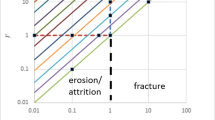Abstract
This paper attempts to answer whether or not the mill performance at Bougainville could have, in fact, been predicted by the population balance approach, or whether other special considerations are required to explain their behavior. In recent studies, the plant tests were performed at Bougainville and batch tests were carried out at the Utah Comminution Center. In all tests power measurements were made and several levels of energy input to grinding were evaluated. Also, tracer tests were performed for mill residence time determination. The performance of Bougainville’s 5.5×6.4-m mill has been very successfully predicted by population balance methods. The prediction errors are only about 1% on product size distribution and 4% on power with a mill volume scale-up of 3790:1. It is significant that this approach will reduce the risk of failure in large mill design that has been recognized in traditional methods.
Similar content being viewed by others
References
Arbiter, N., and Harris, C., 1984, “Scale-Up Problems With Large Ball Mills,” Minerals & Metallurgical Processing, Vol. 1, May, p.4.
Austin, L.G., 1971–1972, “A Review Introduction to the Mathematical Description of Grinding as a Rate Process,” Powder Technology, Vol. 521, pp. 17.
Burns, R.S., and Erskine, J.G., 1984, “Experience With Large Diameter Ball Mills at Bougainville Copper Ltd.,” Minerals & Metallurgical Processing, Vol. 1, May, p. 15.
Herbst, J.A., Grandy, G.A., and Mika, T.S., 1971, “On the Development and Use of Lumped Parameter Models for Continuous Open- and Closed-Circuit Grinding Systems,” Mineral Processing and Extractive Metallurgy, Vol. 80. pp. C193–C198.
Herbst, J.A., and Fuerstenau, D.W., 1973, “Mathematical Simulation of Dry Ball Milling Using Specific Power Information,” Trans. SME-AIME, Vol. 254, p. 343.
Herbst, J.A., Rajamani, K., and Kinnesberg, D.J., 1977. “ESTIMILL: A Program for Grinding Simulation and Parameter Estimation With Linear Models.” University of Utah, Salt Lake City.
Herbst, J.A., and Fuerstenau, D.W., 1980, “Scale-Up Procedure for Continuous Grinding Mill Design Using Population Balance Models,” International Journal of Mineral Processing.
Herbst, J.A., Lo, Y.C., and Rajamani, K., 1985, “Population Balance Model Predictions of the Performance of Large-Diameter Mills,” Minerals & Metallurgical Processing, Vol. 2, May. p. 114.
Herbst. J.A., Lo, Y.C., and Bohrer, J.E., 1987, “Increasing the Capacity of a Phosphate Grinding Circuit with the Aid of Computer Simulation,” Minerals & Metallurgical Processing, Vol. 4, Aug., p. 155.
Himmelblau, D.M., and Bischoff, B.K., 1968, Process Analysis and Simulation, John Wiley. New York.
Hinkfuss, D.A., 1976. “The Bougainville Copper Limited Concentrator.” Flotation, M.C. Fuerstenau, ed., AIME, New York, pp. 1125–1144.
Hodouin, D., Flament, F., and Everell. M.D., 1981, “Material Balance Calculations for Ore and Coal Processing Circuits - Fortran Program BILMAT Users’ Manual,” Laval University, PQ. Canada.
Kjos, D.M., 1979, “Grinding Circuits: Current Status and Projected Future Development.” Proceedings, Annual Meeting of AIME, Minnesota Section. University of Minnesota, Minnea polis.
Lo, Y.C., et al., 1985, “Design Consideration for Large Diameter Bail Mills,” Recent Development in Comminution, Engineering Foundation Conferences’ Symposium, Hawaii.
Lo, Y.C., and Herbst, J.A., 1986, “Consideration of Ball Size Effect in Population Balance Approach to Mill Scale-Up,” Advances in Mineral Processing, P. Somasundaran, ed., Society of Mining Engineers, Inc., Littleton, CO, pp. 33–47.
Reid, K.J., 1965, “A Solution to the Batch Grinding Equations,” Chemical Engineering Science, Vol. 20.
Rogers, R.S.C., and Gardner, R.P., 1979, “Use of a Finite-Stage Transport Concept for Analyzing Residence Time Distributions of Continuous Processes,” AIChE Journal, Vol. 25, No. 2, pp. 229–240.
Rogovin, Z., Lo, Y.C., Herbst, J.A., and Rajamani, K., 1987, “Closed Grinding Circuit Residence Time Distribution Analysis,” Minerals & Metallurgical Processing, Vol. 4, Nov., p. 214.
Author information
Authors and Affiliations
Additional information
SME preprint 87–109, SME Annual Meeting, Denver, CO, February 1987. M&MP paper 87–605. Discussion of this paper must be submitted, in duplicate, prior to Dec. 31, 1988.
Rights and permissions
About this article
Cite this article
Lo, Y.C., Herbst, J.A. Analysis of the performance of large-diameter ball mills at Bougainville using the population balance approach. Mining, Metallurgy & Exploration 5, 221–226 (1988). https://doi.org/10.1007/BF03402514
Received:
Published:
Issue Date:
DOI: https://doi.org/10.1007/BF03402514




